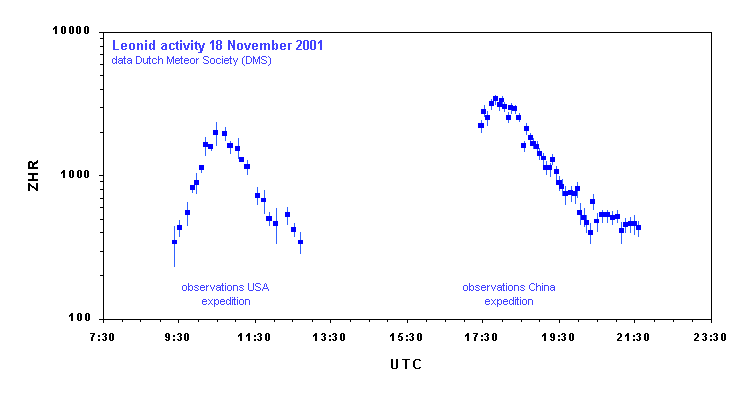
Preliminary results
Leonid storm 2001 observations
7 revolution (1767) and 6 revolutions (1800) dust trails
Safford, Arizona, USA
4 revolutions (1866) dust trail
China

T
his year, the Dutch Meteor Society (DMS) organized 3 expeditions (see www.dmsweb.org) in order to obtain scientific data on the expected storms of the Leonid meteor shower. One expedition set up a multistation network in northeast China and targetted the predicted occurrence of the 4 revolutions (1866 dust) trail and the 9, 10 & 11 revolution trails. Two other expeditions went to the eastern part of the USA and set up two independent multistation networks targetting the predicted occurrence of the 7 revolutions (1766 dust) trail.
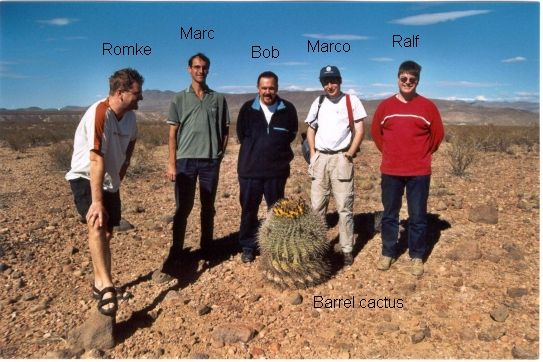
The full observational team at Safford, Arizona, except Rita (who took the picture) gathering in the desert around a barrel cactus: from left to right Romke Schievink, Marc de Lignie, Bob Lunsford, Marco Langbroek and Ralf Mulder
The author of this webpage was part of one of the USA expeditions and set up a station at a scenic and secluded spot in the desert, in the Black Hills near Safford, eastern Arizona. Our multistation partner was at Benson (Jaap van ‘t Leven, Klaas Jobse, Peter Bus), while an American team at Mt. Lemon also joined in. At Safford we operated an image intensified video camera, and visual observations were conducted.
We observed a beatiful meteor storm from the Arizona desert on the night of November 17-18 with peak rates near ZHR 2100. The howling of the Coyotes in the nightly desert was rivaled by the howling of the observers this night! The peak occurred at 10:35 UTC, and I counted up to 44 Leonids per minute near the peak (missing the minutes right at the peak because my tape recorder jammed at that point). The meteors were quite bright with many fireballs up to magnitude –5 and beatiful persistent trains. Although the ZHR was less than the 1999 storm which I observed from Spain, I found the 2001 storm over Arizona much more impressive due to the bright meteors and longer duration (several hours), with raw rates still very high and approaching one meteor per second. This was the best Leonid show I have ever seen!
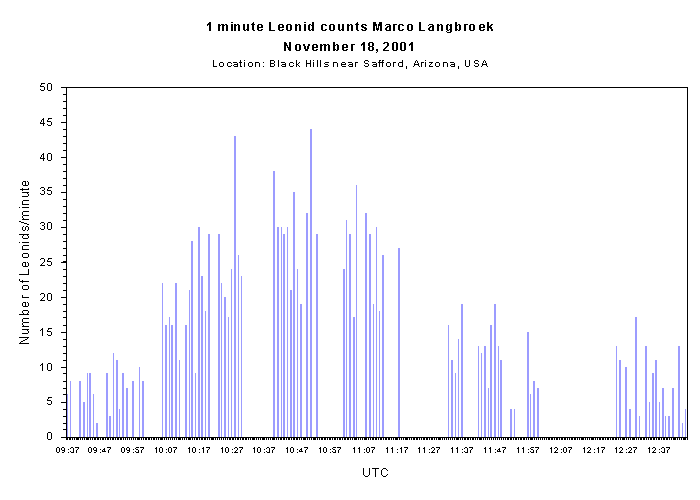
During the early part of the session we had cirrus clouds lowering the limiting magnitude and sometimes necessitating breaks in the session. Earthgrazing bright Leonids made this a worthwhile period of observations though, and we could still gather good data. About one hour before the actual peak moment, the sky cleared completely and we got a sky with limiting magnitudes at +6.7 to +6.8 and zodiacal light visible. The show was astonishing and very impressive.
Below activity curve is a preliminary curve based on the observations of Safford observers Marc de Lignie and Marco Langbroek. Other observers present in Safford were Rita Verhoef, Ralf Mulder, Romke Schievink and Esther de Groot. Data have been reduced with an r-value of 2.0, gamma exponent of –1.4 and with perception coefficients taken into account. The shower can be seen to peak near 10:35 UTC (3:35 local time) with ZHR’s in the order of 2000 to 2500. Near 12:20 UTC, perhaps a glimpse of the modest 6 revolutions trail is visible.
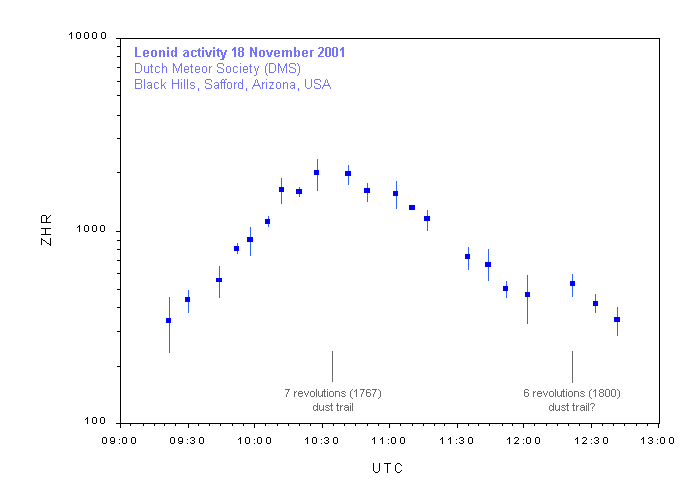
The obtained activity profile matches wonderfully with Esko Lyytinen’s model output for the 7 revolutions (1767 dust) trail. This is very apparent in below diagram, which shows the visual observations from the diagram above as a transparent overlay on Esko Lyytinen’s latest model outputs for the 7 and 6 revolution trail activity (source for these: http://www.saunalahti.fi/fmbb/astro/2001leonidstorm.htm). I find this an extremely impressive result.
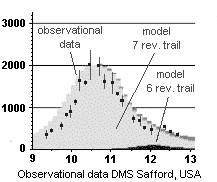
Asian peak: seven and a half hours later, over China, members of our second expedition observed yet another serious surge in activity. Zenith Hourly Rates again reached storm levels, with a peak with peak ZHR around 3400 around 18:00 UTC. These are values about a factor 1.5 higher than the earlier peak over the USA and similar to the 1999 storm over Europe. Reports indicate that the meteors were even more bright during this Asian peak, with fireballs up to –10 magnitude especially some time after the main peak. These post-peak fireballs were presumably due to the 10 and 11 revolution trails. Again, the peak was very broad compared to the 1999 storm.
Below is a very preliminary activity curve based on observations by Koen Miskotte observing from Xinglong observatory near Beijing, Hebei, China. Data were reduced with r=1.8 and gamma exponent –1.4, with perception coefficient taken into account.

added discussion:
For the Asian peak, the match of observed activity with the model output is much less impressive than for the 7 revolutions trail over the USA. Models predicted the 4 revolutions trail to be very strong, but something is wrong. Rates did not come out as high as predicted. They are a mere 50% or less of what was predicted. And the peak (around 18:00 UTC) occurs too early in time: the 4 revolutions peak was predicted to occur around 18:20 (Lyytinen) to 18:14 (Asher & McNaught) UTC.
The 4 revolutions (1866 dust) trail is widely held to have been the main contributor to this years activity peak over Asia. But is that assumption correct? The curve would appear to be more consistent with dominant activity of the 9 revolution trails (1699 dust) rather than dominance of the 4 revolutions trail (1866 dust). This is very apparent in below diagram, which shows the visual observations from the diagram above as a transparent overlay on Esko Lyytinen’s latest model outputs (source for these: http://www.saunalahti.fi/fmbb/astro/2001leonidstorm.htm)

The observed peak time (about 18:00 UTC) is more in line with the predicted peak time (18:03) for the 9 revolution trail. Indeed, the above comparative figure would suggest that activity was due to the 9 revolutions trail and the 4 revolutions trail rather had a (very) modest rate contribution <1000.
Yet, with different trails peaking close in time, it is difficult to decide which trail is the main contributor. This has repercussions for 2002 prospects though. The 4 revolutions trail is predicted to re-occur in 2002 with peak rates at about 7400 near 10:44 UTC, over the USA. The 7 revolutions trail is predicted to re-occur over Europe at about 4:02 UTC with rates at 4500. The 2001 results with a clearly lower than expected 4 revolution trail contribution would indicate that while the 7 revolutions trail peak over Europe might occur much as predicted, the 4 revolutions trail peak over the USA might come out different from what is predicted. And given that trail identifications are open to question, some caution towards equaling the observed Asian peak with the 4 revolutions trail might be advisable.
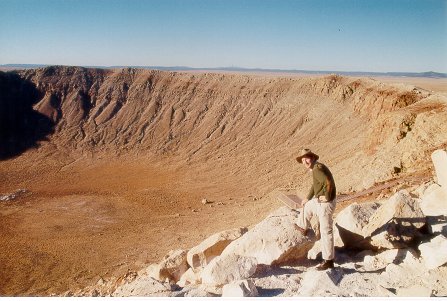
The author of this webpage at Meteor Crater, Arizona, after the Leonid observations
Text and analysis by
Marco Langbroek, Dutch Meteor Society, updated 24 December 2001.Link to Esko Lyytinen’s model predictions
Link to David Asher & Rob McNaught’s model predictions